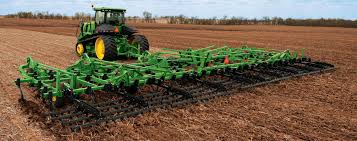Secondary tillage implements can be used either before or after the crop is planted. They may be used to prepare the seedbed, mix fertilizer, break soil crusts, or crush clods left by a primary tillage implement. After the crop is planted, these implements are also used for weeding and minor earthening-up operations.
Read Also: 14 Medicinal Health Benefits of Epimedium grandiflorum (Horny Goat Weed)
Types of Secondary Tillage Implements

The equipment used for secondary tillage is generally referred to as harrows. Some common secondary tillage implements are:
1. Cultivators: These implements typically consist of a set of soil-working tines or shares mounted on a sturdy frame. Depending on the type of tines, cultivators are classified as:
i. Rigid-tine cultivators
ii. Spring-tine cultivators
Cultivators can also be adapted for row crop hoeing by fitting special hoe blades that cut weeds. Small concave discs can be attached, and the cultivator frame is drilled so that the position of the tines can be adjusted to suit the row widths of the crop being hoed.
2. Harrows: A harrow is used to tend the ground by crushing clods, stirring the soil, and controlling weeds. In some conditions, harrows can also be used to cover seeds. The main types of harrows include:
i. Disc harrow
ii. Spike-tooth harrow
iii. Chain harrow
iv. Spring-tooth harrow
3. Rotary Hoe: A rotary hoe consists of revolving shovels that pulverize the soil by impact. The pulverizing action can be controlled by the forward speed of the tractor. Several revolving shovels are mounted on an axle, which is powered by the tractor’s PTO shaft. In dry soil conditions, rotary hoes have limited use due to poor soil penetration, wind, and the discomfort caused by the amount of dust generated.
4. Rollers: This implement is used to break down soil clods that may not have been crushed by cultivators or harrows. Rollers are designed to be drawn quickly behind a tractor so that clods are broken by impact rather than buried or pressed into the soil. Rollers are also useful for conserving moisture and are sometimes used after groundnut digging to ease the separation of pods from the soil.
5. Ridger: A ridger, also referred to as a double mouldboard plough, is used to form ridges. The ridger bodies, mounted on a frame, can be staggered to give the required spacing. Each ridger body carries a narrow share and two mouldboards, with the spacing between the mouldboards being adjustable.
Read Also: Poultry Record Keeping and Performance Evaluation
Maintenance and Care of Secondary Tillage Implements

- Check equipment for proper hitching.
- Inspect hydraulic units to ensure proper operation.
- On disc harrows, check the gang angling system.
- Store implements in a shed during the off-season, on concrete slabs, planks, or blocks.
- Remove wheels with rubber tires and store them in the shed.
- Tag wheels, noting the implement and their position on the implement.
- Apply anti-rust grease or oil to discs and soil-wearing parts.
- Make a list of necessary repairs and place orders for replacements.
- Cover hydraulic hose ends with plastic, tied securely.
- If stored outside, cover the implements with plastic or canvas sheets, tied securely.
In this article, the various secondary tillage implements and their maintenance have been discussed. Proper maintenance ensures the implements last longer and perform effectively, helping achieve the desired results in the field.
Do you have any questions, suggestions, or contributions? If so, please feel free to use the comment box below to share your thoughts. We also encourage you to kindly share this information with others who might benefit from it. Since we can’t reach everyone at once, we truly appreciate your help in spreading the word. Thank you so much for your support and for sharing!
Frequently Asked Questions
We will update this section soon.

